- Fabrication of Transmittance Tunable Porous Elastomers for Smart Window Applications
Mira Shin# , Youngeun Lee# , Jinkyung Kim# , Gun Woo Sim# , Youngho Eom, Se-Um Kim*,†
 , and Dae Seok Kim†
, and Dae Seok Kim† 
Pukyong National University, Department of Polymer Engineering, 45 Yongso-ro, Nam-gu, Busan 48513, Korea
*Department of Materials Science and Engineering, University of Pennsylvania, 3231 Walnut Street, Philadelphia, PA 19104, USA- 스마트 윈도우 응용을 위한 광 투과 조절 가능 다공성 엘라스토머 제작
부경대학교 고분자공학과, *펜실베니아대학교 재료공학과
Reproduction, stored in a retrieval system, or transmitted in any form of any part of this publication is permitted only by written permission from the Polymer Society of Korea.
In this study, we propose a smart window application based on a porous silicone elastomer film that can control light transmittance by compression. A porous elastomeric film was produced by emulsification of isopropyl alcohol aqueous solution in a platinum-catalyzed silicone known as an Ecoflex. It was shown that pores with a size of several hundred nanometers to several tens of micrometers induce light-scattering in the visible light region due to the difference in refractive index with the Ecoflex matrix, and the transmittance could be controlled as the pores were closed by applying compression on the film thickness. It was confirmed that the transmittance can be reversibly adjusted with a fast reaction rate of less than 1 second, and the deterioration is very small even in repeated driving. Furthermore, for smart window application, a press-type window with a porous Ecoflex film was demonstrated. The fabrication process is very simple and economically preferred, and it can be applied as a base technology for an energy-saving smart window that can maintain indoor temperature and illumination without electrical energy.
연구에서는 압착을 통해 투과도 조절이 가능한 다공성 실리콘 엘라스토머 필름을 제작하고 이를 기반으로 한 스마트 윈도우 응용을 제안한다. Isopropyl alcohol 수용액이 Ecoflex 전구체와 상분리가 되는 것을 이용해 Ecoflex 몸체에 다공성 구조를 가진 필름을 제작하였다. 수백 nm에서 수십 mm 크기의 기공이 Ecoflex 몸체와 굴절률 차이로 가시광 영역에서 산란을 일으키고 필름 압착 시 기공이 닫히면서 투과도 조절이 가능함을 보였다. 광 투과도를 가역적으로, 1초 이하의 빠른 반응속도로 조절할 수 있으며 반복 구동에도 열화가 매우 적음을 확인하였다. 나아가 스마트 윈도우 응용을 위해, 다공성 Ecoflex 필름이 삽입된 압착형 창문을 제작하여 응용성을 시연하였다. 이 다공성 Ecoflex 필름의 제작 공정이 매우 단순하며, 실내 온도 및 조도 유지를 전기적 에너지 없이 가능한 에너지 절약형 스마트 윈도우의 기반 기술로 응용될 수 있다.
A transmittance tunable porous elastomeric film was developed using an emulsion of pre-polymer known as Ecoflex and isopropyl alcohol (IPA) aqueous solution. The micro-porous structure induces light-scattering in the visible light region due to the difference in refractive index with the Ecoflex matrix, and the transmittance could be controlled as the pores were closed by applying compression over the film thickness. Here, transmittance tunable smart window was demonstrated using the porous elastomeric film without electric or heat energy source.
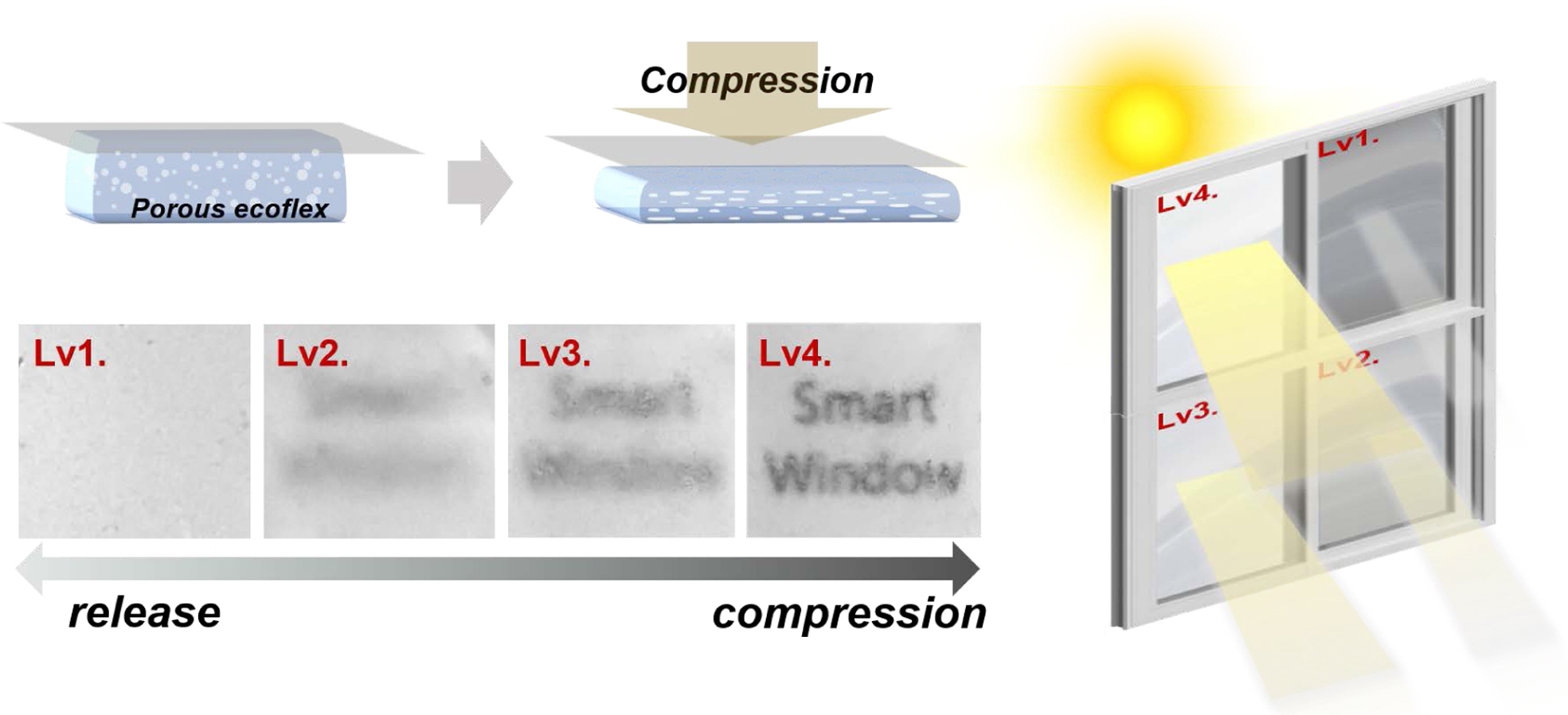
Keywords: smart window, porous elastomer, light scattering, Ecoflex, tunable transmittance.
이 논문(또는 저서)은 부경대학교 자율창의학술연구비(2020년)에 의하여 연구되었음.
저자들은 이해상충이 없음을 선언합니다.
3 mm 두께의 다공성 Ecoflex 필름을 두께에 수직한 방향으로 압착 및 풀기를 하는 동안 투과도 변화 동영상. 이 자료는 다음 사이트에서 얻을 수 있습니다(http://journal.polymer-korea.or.kr).
PK_2021_045_06_934_Supporting_Information_template.avi (2341 kb)
Supplementary Information
창문은 건물, 자동차, 비행기 등의 실내에서 실외를 연결시키는 장치로써, 조명, 단열, 미관, 소음차단 및 공기순환 등 다양한 기능을 수행할 수 있다.1 특히, 창문의 설계는 빛을 투과, 반사, 또는 산란시켜 실내의 온도 및 조도를 결정하는데 매우 중요하다. 2020년 국제에너지기구(IEA) 보고에 따르면
건물 에너지가 전체 에너지의 36%를 차지하고, 이 중 냉난방은 비중이 가장 높아 건물 에너지 절감을 위한 핵심 관리 요소다.2 선행 연구들은 창문의 광 산란 및 투과를 최적화 시킬 때 냉난방 및 조명에 사용되는 에너지의 약 50% 이상을 줄일 수 있다고 보고하였다.3 이에 따라 광 기능의 능동적 조절이 가능한 스마트 윈도우에 대한 연구가 진행되고 있다.4-9 대표적 스마트 윈도우 기술로 전기변색,10,11 입자분산,12,13 그리고 고분자분산액정5,14,15 방식 등이 있으며, 이들은 광 투과도 또는 색조를 전기적으로 스위칭할 수 있는 시스템이다.16 그 밖에도, 열, 화학 반응, 또는 기계적 방식으로 구동되는 스마트 윈도우가 개발되고 있다.17-20 하지만 전기나 열을 사용하는 구동방식은 특정 상태를 유지하기 위해 지속적으로 고밀도 에너지를 사용해야 하는 단점이 있다. 이에 기계적 변형으로 광 투과도를 조정할 수 있는 고분자 복합소재기반 물질들이 제안되었다. 박막형태로 제작된 이런 고분자 소재에서 40% 이상의 유효한 투과도 변화를 확보하기 위해서는 평면 축으로 30% 이상의 변형을 가해야 가능하다. 이에 따라 피로누적에 따른 장치 수명 감소 및 신뢰성 저하 등의 문제들을 유발할 수 있다. 따라서 작은 변형에도 투과도를 크게 변화시키는 새로운 물질 개발 및 구동 방식에 대한 연구가 필요하다. 이에 본 연구에서는 마이크로 기공을 포함하는 엘라스토머 필름을 제작하여 박막의 수직 축으로 기계적 압력을 가해 빛의 산란도를 조절할 수 있는 방법을 제안한다. 이 다공성 필름은 시중에 쉽게 구매가능한 실리콘 기반의 고분자소재인 Ecoflex를 사용하여 제작하므로 접근성이 높다. 제작 과정에서는 isopropyl alcohol(IPA) 수용액을 Ecoflex 전구체와 섞어 물리적으로 교반하는 간단하고 저렴한 one-pot 방식을 사용한다. 제작된 다공성 광산란 필름은 압착하는 힘에 따라 기공이 눌림이 연속적이고 가역적으로 변하며 이에 따라 투과도를 조절할 수 있다(Scheme 1). 특히, 전기나 열과 같은 고밀도 에너지를 사용하지 않고도 투과도를 선택하고 유지할 수 있는 시스템이기 때문에 에너지 효율성이 높은 스마트 윈도우 개발에 기반 기술로 사용될 수 있다. 나아가 건물 창호, 보안용 디스플레이, 차량, 항공우주 및 의료 기기 등의 다양한 분야에 활용될 수 있을 것이다.

Scheme 1. Conceptual diagram of light transmittance control through compression of porous Ecoflex film.
시약 및 시료. 본 연구에서 Ecoflex 00-30(smooth-on, Inc, 미국)을 SFX Korea에서 구입하였고, IPA는 ㈜덕산케미칼(Korea)에서 구입하였다.
다공성 용액 제조(Figure 1). 다공성 Ecoflex 필름을 제조하기 위해 Ecoflex 전구체와 물 및 IPA의 상 분리 현상을 이용하였다. Ecoflex 전구체는 Ecoflex 00-30(Smooth On)의 주제(Part A)와 경화제(Part B)를 1:0.9로 섞어서 준비하였다. 50 wt%의 IPA 수용액을 만들어 Ecoflex 전구체와 1:1.3 비율로 섞었다. 이때 Ecoflex 전구체가 연속상이고, IPA 수용액이 분리상인 에멀션(emulsion)이 형성된다. 분리상의 크기를 수 mm 이하로 만들기 위해 전동교반기(MS3040, 미성과학기기, 대한민국)로 20분간 혼합하였다.
다공성 필름 제조. 앞의 과정에서 제조한 에멀전은 원하는 두께를 가지도록 양을 조절하여 평평한 페트리디쉬 용기에 옮겨 담는다. 이후 진공 챔버로 에멀전 시료를 옮겨 30분 동안 불필요한 기체나 용매를 방출시켰다. 이 후 에멀전 시료를 75 oC의 오븐에서 30분 열경화를 통해 필름을 완성하였다.
구조 및 광 특성 분석. 제작된 다공성 필름의 내부구조 및 기공분포를 관찰하기 위하여 광학현미경(Eclipse LV100N POL, Nikon, 일본)과 전계주사전자현미경(field emission scanning electron microscope, FE-SEM, MIRA 3 LMH In-Beam Detector)을 사용하였다. 또한 압착에 따른 다공성 필름의 투과도 및 회복력에 따른 투과도 변화속도를 측정하기 위하여 광학현미경에 장착된 UV-VIS spectrometer(USB-2000, Ocean optics, 미국)를 이용하였다.
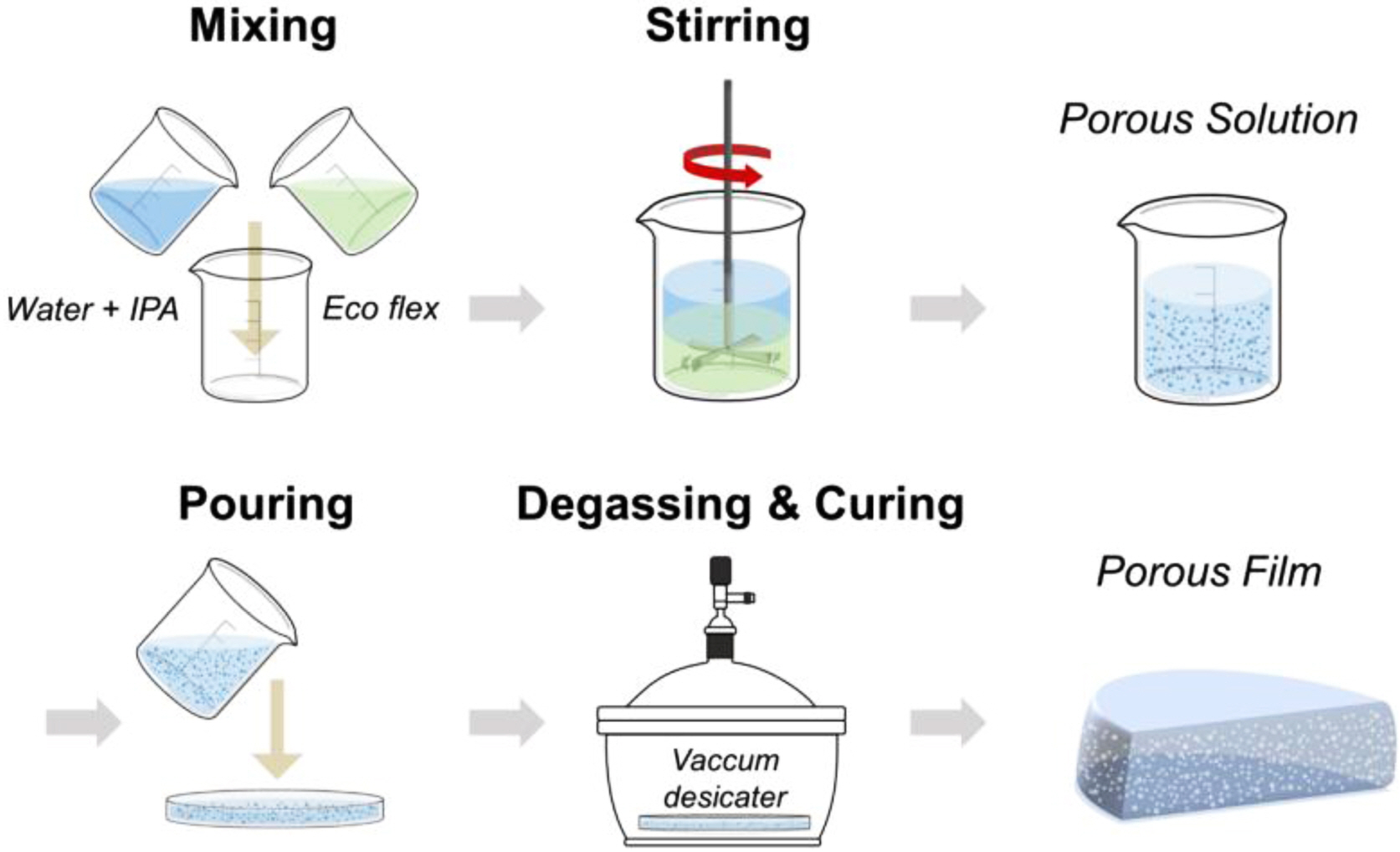
|
Figure 1 Illustration of fabricating the porous Ecoflex film. |
압착 실험 및 다공성 구조 분석.
3 mm 두께를 가지는 다공성 Ecoflex 필름의 상부와 하부에 아크릴 판을 위치시켜 다공성 Ecoflex 필름의 압착 전, 후의 다공성 구조 차이 및 광 특성 변화를 분석하였다(Figure 2(a)). 다공성 Ecoflex 필름의 압착 전, 전자현미경 사진을 통해 기공의 크기가 수백 nm에서부터 수 mm 크기로 분포하는 것을 확인하였다(Figure 2(b)). 따라서 기공과 Ecoflex 몸체 부분의 굴절률 차이에 의해 기공의 크기와 유사한 가시광 영역(380-750 nm)에서 산란이 발생할 수 있다. 육안으로 확인 결과, 압착 전 다공성 Ecoflex 필름의 하부에 놓여있는 이미지를 볼 수 없었다(Figure 2(c)). 다공성 Ecoflex 필름이 1.2 mm 두께를 가지도록 압착되었을 때 기공이 닫히면서 기공이 없는 Ecoflex 필름과 유사한 내부 형태를 보이는 것을 확인할 수 있다(Figure 2(d)). 기공이 압착되면서 굴절률 차이가 사라지기 때문에 하부 이미지가 관측되며 압착 전 후의 상태는 가역적으로 변할 수 있다(Figure 2(c)).
Figure 3(a)는 기공이 없는 Ecoflex 필름과 다공성 Ecoflex 필름의 압착 정도에 따른 투과도 차이를 나타낸다. 기공이 없는 필름은 투과도가 약 85%이다. 다공성 Ecoflex 필름의 압착 정도를 증가시켜 필름의 두께가 감소할 때 투과도가 증가한다. 이 때 줄어든 두께에 따라 투과도가 선형적으로 증가함을 알 수 있다. 이는 압착이 진행되면서 기공의 부피가 압착된 두께에 비례하여 줄어들었기 때문이라고 추론된다. 3 mm 두께의 다공성 Ecoflex 필름의 경우, 1.2 mm 두께로 압착되었을 때 약 50%까지 투과도가 증가하였고, 기공이 완전히 닫힌 상태가 되어 후속 압착에서 투과도가 크게 증가하지 않았다. 또한 후속 압착을 진행하여도 두께가 크게 감소하지 않는 것을 확인하였다. 3 mm 두께의 기공이 없는 Ecoflex 필름이 약 85% 투과도를 가지는 것으로 봤을 때, 압착 방식으로 완전히 닫히지 않는 미세한 공간이 남아 잔여 산란이 발생한다고 판단한다. 또한 기공에 의한 빛의 산란을 정량화 하기 위해 동일한 두께 조건에서 기공의 유무에 따른 투과도를 분석하였다(Figure 3(b)). 3 mm와 6 mm 두께의 다공성 Ecoflex 필름을 제작하였고, 6 mm 두께 필름을 3 mm로 압착하여 두 필름의 투과도를 측정하였다. 압착한 필름의 경우, 압착하지 않은 필름보다 가시광 영역에서 투과도가 더 높게 나타난다. 이 때, 기공의 크기가 산포를 갖기 때문에 가시광 전영역에서 균일하게 투과도가 변하는 것을 확인할 수 있다. 이 결과를 통해, 이 다공성 Ecoflex 필름이 단순히 압착에 따른 두께의 감소로 투과도 증가가 야기된 것이 아닌, 실제 다공성 필름 내 기공들이 압착에 따라 닫히게 되면서 기공에 의한 산란도를 낮춘다는 것을 확인할 수 있었다. 또한, 앞서 언급한 Figure 2(d)에서 압착을 가했을 때 기공이 닫힌 구조가 관찰되는 결과와 부합하는 것을 뒷받침한다. 다음으로, 필름의 압착에 따른 안정성과 투과도 변화의 신뢰성을 검사하기 위해서 압착과 풀기를 1000회 반복하는 실험을 통해 다공성 Ecoflex 필름의 투과도 조절이 비교적 일정하고 가역적임을 확인하였다(Figure 3(c) 및 Movie S1 in Supporting Information). 압착을 1000회 반복하여도 최대 투과도가 50%로 유지되고 두께변화도 없었으므로, 다공성 구조가 반복 구동에도 변형이 일어나지 않음을 알 수 있다.
다공성 Ecoflex 필름의 스마트 윈도우에 응용하기 위해서는 투과도 조절이 압착에 따라 즉각적으로 반영되어야 한다. 이에, 추가적으로, 다공성 Ecoflex 필름의 압착-투과 반응속도를 측정하기 위해, 압착 후 투명해진 필름에 힘을 제거한 후 가역적으로 불투명한 상태로 돌아오는 데 걸리는 시간을 측정하였다(Figure 3(d)). 투과도가 원복되는데 약 0.6초로, 매우 짧은 시간이 소요되었다(Movie S1). 응력에 빠른 따른 탄성변형과 원복은 전자 및 광학소자 응용에 매우 중요하게 고려되어야 할 요소이다. 이전 논문에서,21 실리콘 기반의 엘라스토머 중에서 Ecoflex 물질은 변형에 따른 원복의 이력현상이 거의 나타나지 않는 매우 탁월한 탄성변형 특성을 보였다. 이는 본 Figure 3(d)에서 측정된 결과인 압착에 따른 빠른 변형 및 원복 결과를 뒷받침한다.
스마트 윈도우 응용.가역적으로 투과도가 변하는 다공성 Ecoflex 필름을 스마트 윈도우에 적용할 수 있다. Figure 4(a)와 같이 두 아크릴 판 사이에 3 mm 두께의 다공성 Ecoflex 필름을 배치하고 아크릴 판에 구멍을 형성하여 볼트와 너트를 결착하였다. 너트를 조이면 그 정도에 따라 필름이 압착된다. 이 때, Lv.은 볼트와 너트를 조인 정도, 즉 다공성 Ecoflex 필름의 압착 정도를 나타낸다. Lv.1에서 Lv.4까지 압착을 진행할 때 다공성 Ecoflex 필름의 투과도 변화가 Figure 4(b)에 나타나 있다. 비교적 적게 압착한 Lv.1의 경우, 기공이 거의 닫히지 않아 필름 후면의 이미지가 관찰되지 않는다. Lv.을 증가시킬수록 투과도는 증가하고, Lv.4에서 기공이 완전히 눌리게 되어 후면 이미지가 뚜렷하게 보인다. 이러한 다공성 Ecoflex 필름을 창문에 일체형으로 배치하거나, 또는 공간적으로 구분 배치하여 위치마다 서로 다른 투과도를 가질 수 있도록 독립적으로 조절할 수도 있다(Figure 4(c)). 다공성 Ecoflex 필름의 연속적인 투과도 조절이라는 본 연구결과는 실내 온도 및 조도 유지를 적은 에너지만을 사용하여 구동되는 신개념 스마트 윈도우 제작에 유용한 기반기술로 활용될 수 있을 것으로 생각된다.
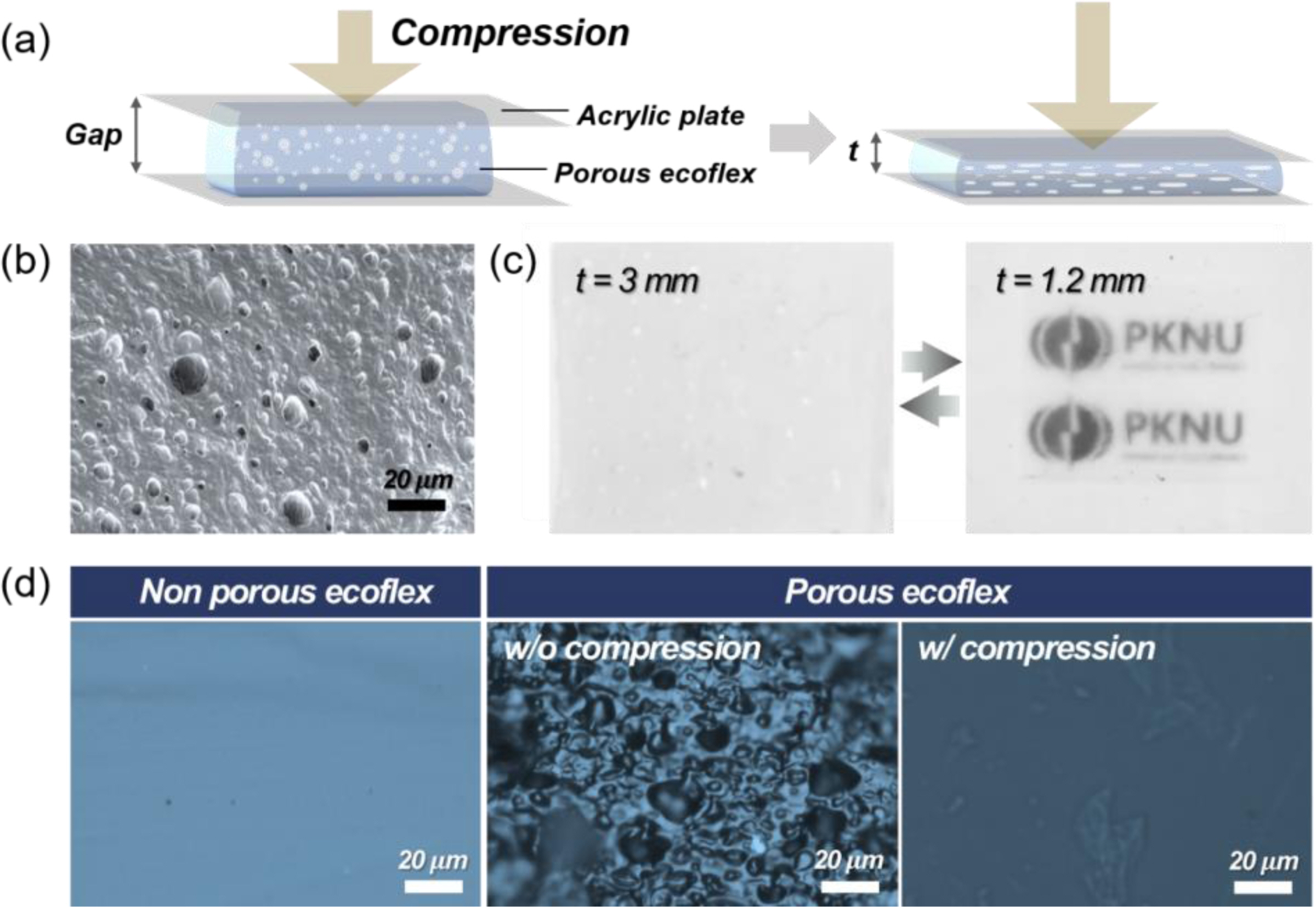
|
Figure 2 Changes in internal structure and light transmittance according to compression of porous Ecoflex film: (a) Schematic illustration of the compressive porous Ecoflex film in a sandwiched acrylic plate; (b) The cross-sectional SEM image of the porous Ecoflex film before compression; (c) Changes in transmittance before and after compression of the porous Ecoflex film; (d) Optical microscope images of nonporous Ecoflex film and porous Ecoflex film before and after compression. |
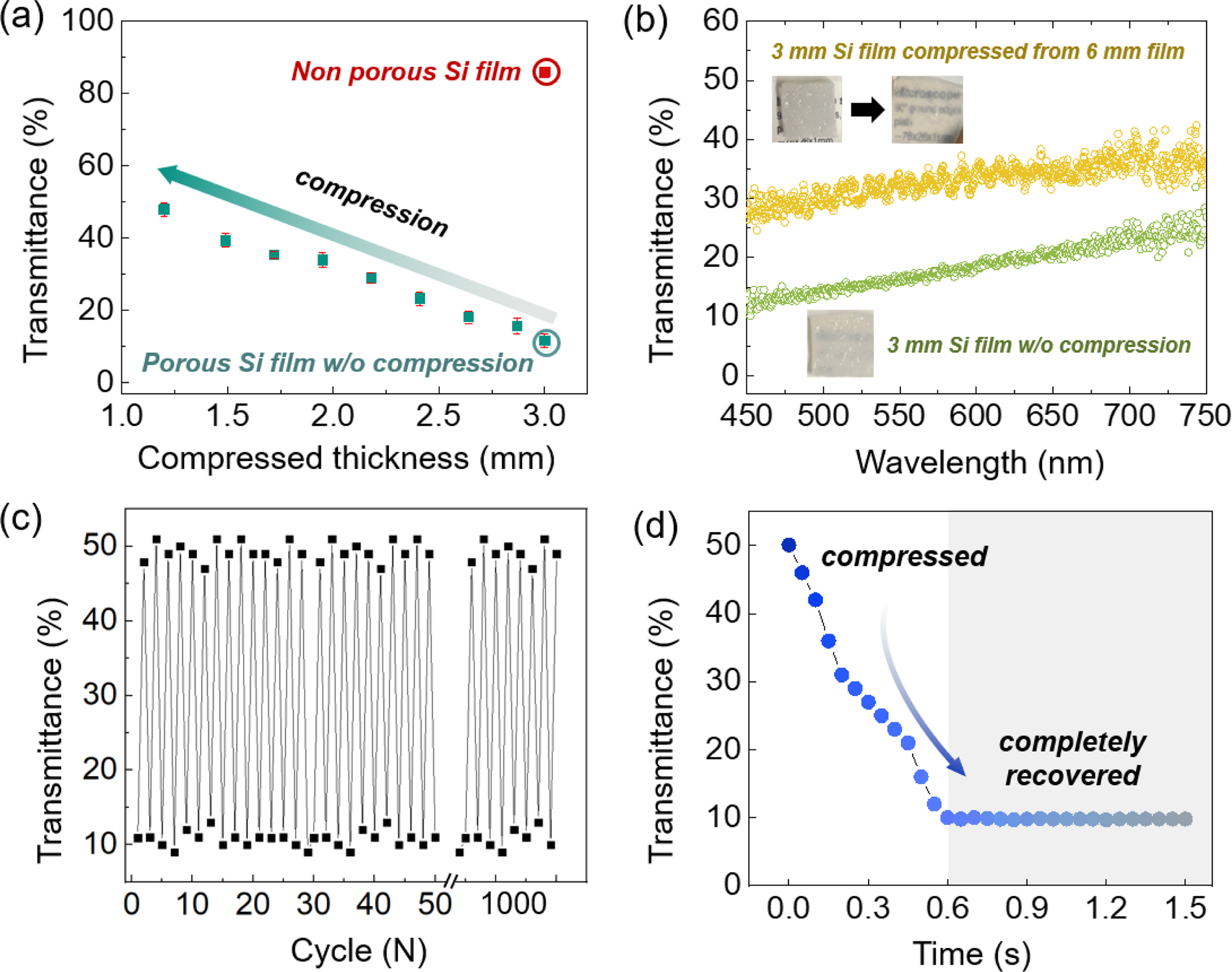
|
Figure 3 Characterization of transmittance changes in visible region during compression of porous Ecoflex film: (a) Optical transmission spectra of the porous Ecoflex film during compression and non-porous Ecoflex film; (b) Optical transmission spectra of the 3 mm- and 6 mmthick porous Ecoflex films, in which the 6 mm-thick film was compressed to 3 mm; (c) Optical transmission spectrum of porous Ecoflex films during Cycling test of compression and release; (d) Optical transmission spectrum showing the rate to recover the initial opaqueness of the porous Ecoflex film without compression after releasing. |
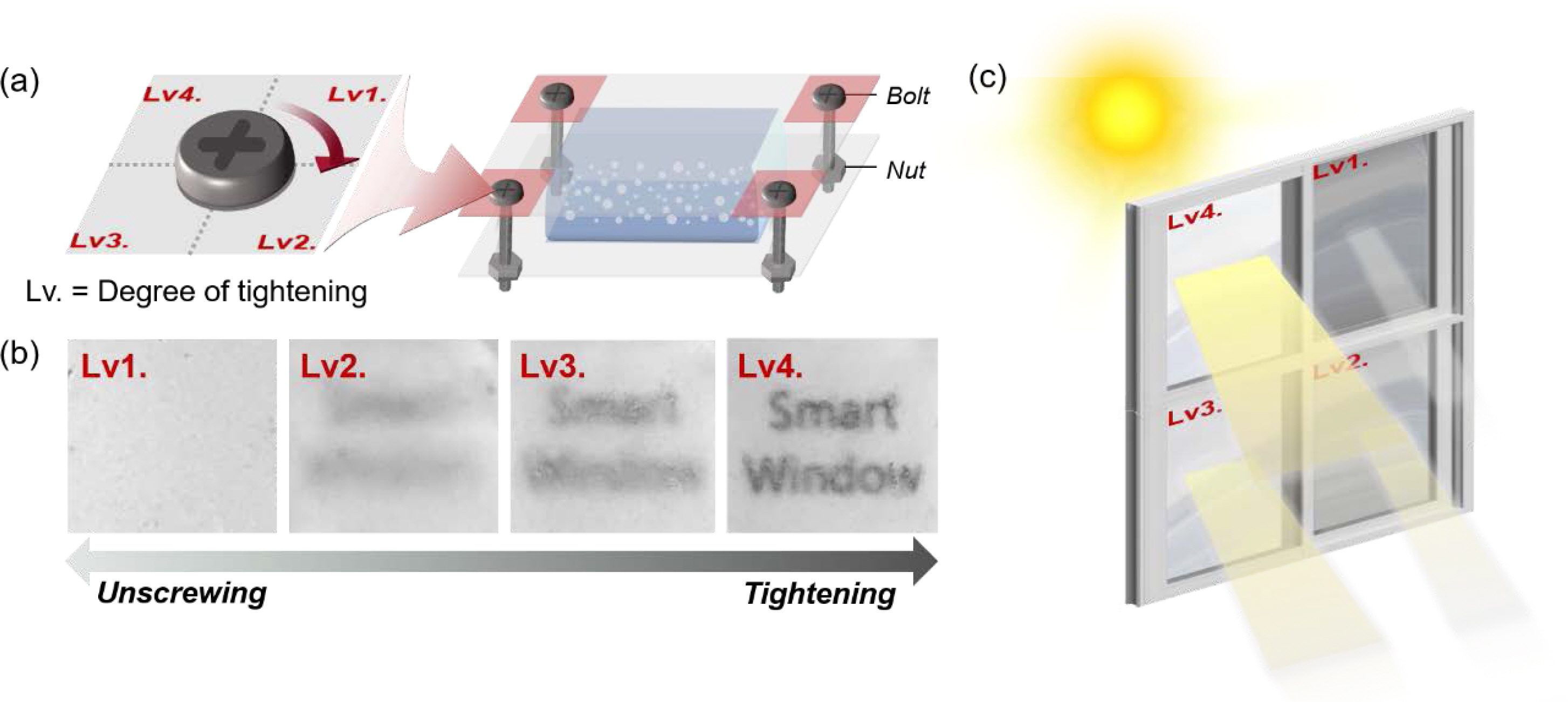
|
Figure 4 Smart window application of porous Ecoflex film: (a) Schematic diagram of smart window based on the porous Ecoflex film. The upper and lower acrylic plates are fastened with bolts and nuts to control the degree of compression. Lv. means the degree of tightening the nut; (b) Photographs of the porous Ecoflex-based compressive smart window as Lv. increases by tightening the nut; (c) Conceptual diagram of a smart window that can independently control the transmittance for each location by spatially dividing the porous Ecoflex film. |
본 연구에서 제안하는 다공성 구조의 제작은 단순하고 저비용 공정이 가능한 방법이다. 또한 기존의 실리콘 제작공정과 동일하게 주제와 경화제를 용액상으로 혼합하여 제작하는 용액공정을 진행하기 때문에 원하는 면적과 모양의 주형화가 매우 용이하여 다양한 형태의 대면적 필름 제작이 유리하다. 이번 연구에서는 상용 물질인 Ecoflex를 활용하였으나, 최대 투과도 상향과 구동에 필요한 압착을 줄이는 방향으로 소재 개발이 추가로 진행될 수 있다. 또한 센서와 구동 장치를 추가하여 외부의 조건에 감응하여 스스로 압착을 수행하는 구동법을 구현할 수도 있다. 스마트 윈도우는 이미 상용화 되었고, 색 변화, 가격 문제, 약한 내구성, 수동성 등의 문제를 개선하기 위한 연구가 지속된다면 적용을 확대시킬 수 있다. 스마트 윈도우 기술은 태양전지, 바이오 센서, 의료 기기와 같은 응용분야에도 사용될 수 있다. 또한 자동차, 기차, 항공기 등의 수송분야, 디스플레이와 반도체 등의 정보 분야 등 다양한 산업에서 긍정적인 영향을 줄 것으로 예상한다.
- 1. Baetens, R.; Jelle, B. P.; Gustavsen, A. Properties, Requirements and Possibilities of Smart Windows for Dynamic Daylight and Solar Energy Control in Buildings: A State-of-the-art Review. A. Sol. Energy Mater. Sol. Cells 2010, 94, 87-105.
-

- 2. Nundy, S.; Mesloub, A.; Alsolami, B. M.; Ghosh, A. Electrically Actuated Visible and Near-infrared Regulating Switchable Smart Window for Energy Positive Building: A Review. J. Clean. Prod. 2021, 301, 126854.
-

- 3. Khandelwal, H.; Schenning, A. P. H. J.; Debije, M. G. Infrared Regulating Smart Window Based on Organic Materials. Adv. Energy Mater. 2017, 7, 1602209.
-

- 4. Bechinger, C.; Ferrere, S.; Zaban, A.; Sprague, J.; Gregg, B. A. Photoelectrochromic Windows and Displays. Nature 1996, 383, 608-610.
-

- 5. Cupelli, D.; Nicoletta, F. P.; Manfredi, S.; Vivacqua, M.; Formoso, P.; De Filpo, G.; Chidichimo, G. Self-adjusting Smart Windows Based on Polymer-dispersed Liquid Crystals. Sol. Energy Mater. Sol. Cells 2009, 93, 2008-2012.
-

- 6. Ke, Y.; Chen, J.; Lin, G.; Wang, S.; Zhou, Y.; Yin, J.; Lee, P. S.; Long, Y. A Smart Windows: Electro-, Thermo-, Mechano-, Photochromics, and Beyond. Adv. Energy Mater. 2019, 9, 1902066.
-

- 7. Granqvist, C. G. Electrochromics and Thermochromics: Towards a New Paradigm for Energy Efficient Buildings. Mater. Today Proc. 2016, 3, S2-S11.
-

- 8. Li, J.; Lu, X.; Zhang, Y.; Ke, X.; Wen, X.; Cheng, F.; Wei, C.; Li, Y.; Yao, K.; Yang, S. Highly Sensitive Mechanoresponsive Smart Windows Driven by Shear Strain. Adv. Funct. Mater. 2021, 2102350.
-

- 9. Sol, J. A. H. P.; Timmermans, G. H.; van Breugel A. J.; Schenning, A. P. H. J.; Debije, M. G. Multistate Luminescent Solar Concentrator “Smart” Windows. Adv. Energy Mater. 2018, 8, 1702922.
- 10. Lee, J., Sundar, V. C.; Heine, J. R.; Bawendi, M. G.; Jensen, K. F. Full Color Emission from II-VI Semiconductor Quantum Dot-Polymer Composites. Adv. Mater. 2000, 12, 1102-1105.
-

- 11. Zhou, Q.; Bai, Z.; Lu, W. G.; Wang, Y.; Zou, B.; Zhong, H. In Situ Fabrication of Halide Perovskite Nanocrystal-Embedded Polymer Composite Films with Enhanced Photoluminescence for Display Backlights. Adv. Mater. 2016, 28, 9163-9168.
-

- 12. Vergaz, R.; Sánchez-Pena, J.-M.; Barrios, D.; Vázquez, C.; Contreras-Lallana, P. Modelling and Electro-optical Testing of Suspended Particle Devices. Sol. Energy Mater. Sol. Cells 2008, 92, 1483-1487.
-

- 13. Nundy, S.; Ghosh, A. Thermal and Visual Comfort Analysis of Adaptive Vacuum Integrated Switchable Suspended Particle Device Window for Temperate Climate. Renew. Energy 2020, 156, 1361-1372.
-

- 14. Sheraw, C. D.; Zhou, L.; Huang, J. R.; Gundlach, D. J.; Jackson, T. N.; Kane, M. G.; Hill, I. G.; Hammond, M. S.; Campi, J.; Greening, B. K.; West, J. Organic Thin-film Transistor-driven Polymer-dispersed Liquid Crystal Displays on Flexible Polymeric Substrates. J. Appl. Phys. Lett. 2002, 80, 1088-1090.
-

- 15. Guo, S.-M.; Liang, X.; Zhang, C.-H.; Chen, M.; Shen, C.; Zhang, L.-Y.; Yuan, X.; He, B.-F.; Yang, H. Preparation of a Thermally Light-Transmittance-Controllable Film from a Coexistent System of Polymer-Dispersed and Polymer-Stabilized Liquid Crystals. ACS Appl. Mater. Interfaces 2017, 9, 2942-2947.
-

- 16. Ghosh, A.; Norton, B. Advances in Switchable and Highly Insulating Autonomous (Self-powered) Glazing Systems for Adaptive Low Energy Buildings. Renew. Energy 2018, 126, 1003-1031.
-

- 17. Lee, S. G.; Lee, D. Y.; Lim, H. S.; Lee, D. H.; Lee, S.; Cho, K. Switchable Transparency and Wetting of Elastomeric Smart Windows. Adv. Mater. 2010, 22, 5013-5017.
-

- 18. Kamalisarvestani, M.; Saidur, R.; Mekhilef, S.; Javadi, F. S. Performance, Materials and Coating Technologies of Thermo- chromic Thin Films on Smart Windows. Renew. Sustain. Energy Rev. 2013, 26, 353-364.
-

- 19. Zhang, K.; Zhang, M.; Feng, X.; Hempenius, M. A.; Vancso, G. J. Switching Light Transmittance by Responsive Organometallic Poly(ionic liquid)s: Control by Cross Talk of Thermal and Redox Stimuli. Adv. Funct. Mater. 2017, 27, 1702784.
-

- 20. Aburas, M.; Soebarto, V.; Williamson, T.; Liang, R.; Ebendorff-Heidepriem, H.; Wu, Y. Thermochromic Smart Window Techno- logies for Building Application: A Review. Appl. Energy 2019, 255, 113522.
-

- 21. Lee, W. J.; Park, S.-Y.; Nam, H. J.; Choa, S.-H. Mechanical and Optical Characteristics of Transparent Stretchable Hybrid Sub- strate using PDMS and Ecoflex Material. J. Microelectron. Packag. Soc. 2018, 25, 129-135.
-

- Polymer(Korea) 폴리머
- Frequency : Bimonthly(odd)
ISSN 0379-153X(Print)
ISSN 2234-8077(Online)
Abbr. Polym. Korea - 2023 Impact Factor : 0.4
- Indexed in SCIE
 This Article
This Article
-
2021; 45(6): 934-939
Published online Nov 25, 2021
- 10.7317/pk.2021.45.6.934
- Received on Aug 2, 2021
- Revised on Aug 19, 2021
- Accepted on Aug 24, 2021
 Services
Services
Shared
 Correspondence to
Correspondence to
- Se-Um Kim* , and Dae Seok Kim
-
Pukyong National University, Department of Polymer Engineering, 45 Yongso-ro, Nam-gu, Busan 48513, Korea
*Department of Materials Science and Engineering, University of Pennsylvania, 3231 Walnut Street, Philadelphia, PA 19104, USA - E-mail: seumkim@sas.upenn.edu, daeseok@pknu.ac.kr
- ORCID:
0000-0001-6897-0706, 0000-0002-7481-1434








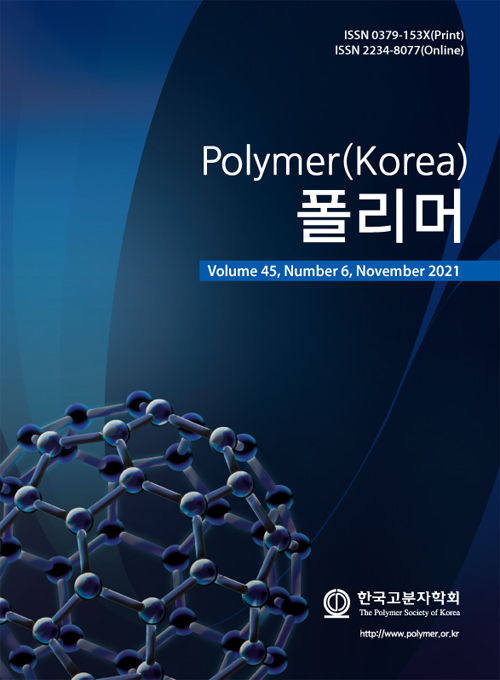
 Copyright(c) The Polymer Society of Korea. All right reserved.
Copyright(c) The Polymer Society of Korea. All right reserved.